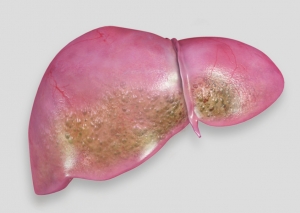What is Fatty Liver Disease?
Fatty liver disease is a condition caused by excess fat buildup in the liver cells. It is most common in middle-aged people. Fatty liver disease is also called hepatic steatosis. Fatty liver is of two types:
- Non-alcoholic Fatty Liver: Buildup of fat in the liver is not associated with the consumption of alcohol.
- Alcoholic Fatty Liver: Buildup of fat in the liver is associated with excess alcohol consumption.

Simple fatty liver is an early stage of fatty liver disease and often not serious. Nonalcoholic Steatohepatitis (NASH) is an advanced stage that causes inflammation of the liver and damage to liver cells causing liver cirrhosis, liver cancer, ascites, and ultimately, liver failure
Symptoms of Fatty Liver Disease
Symptoms of NASH include:
- Enlarged liver
- Pain in the upper abdomen
- Fatigue
- Yellowing of eyes and skin
- Swelling of abdomen and legs
- Enlarged blood vessels
- Enlarged breasts in men
- Mental confusion
- Tiredness and weakness
Risk Factors
Several risk factors are associated with non-alcoholic fatty liver disease:
- Hypothyroidism (underactive thyroid)
- High levels of triglycerides (fat) in the blood
- Fat concentrated in the abdomen
- High blood pressure
- Diabetes
- High intake of refined carbohydrates or sugary beverages
- Impaired gut health
- Chronic hepatitis
- Polycystic Ovary Syndrome
- Sleep apnea
Diagnosis of Fatty Liver Disease
Your doctor will ask for your symptoms and perform a physical examination. Your doctor will also take your medical history such as your lifestyle habits, alcohol consumption, history of liver disease, etc. Blood tests including alanine aminotransferase test (ALT) and aspartate aminotransferase test (AST) may be ordered to check elevated levels of liver enzymes associated with inflammation. Imaging techniques such as an X-ray or CT-scan or MRI may be used to check for excess fat in the liver.
Liver biopsy: It is recommended if your doctor suspects liver cirrhosis. You will be given medicines to manage pain and help you relax. Your doctor numbs the abdomen area at the site of needle insertion. A small amount of liver tissue is taken with the help of a special needle and send to the laboratory for observation.
Treatment of Fatty Liver Disease
The treatment options include:
- Quitting alcohol consumption
- Weight loss
- Managing diabetes and blood pressure
- Getting your cholesterol down
- Exercise
- Preventing hepatitis
- Consuming nutritious food
- Cutting excess sugars and refined carbohydrates in your diet
- Antiviral medications (if hepatitis is the cause)
- Liver transplant (in the case of liver failure)








